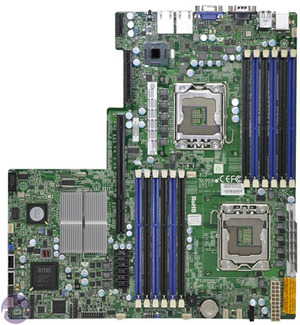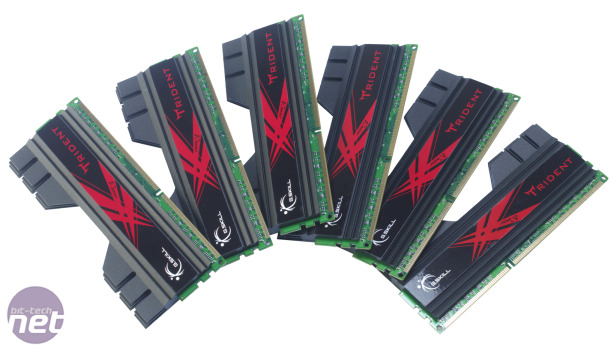Testing Methods
With the exception of wPrime which we use to measure theoretical CPU performance, all of our benchmarks use real applications that give you a great idea of how well a product fares when performing the tasks you're likely to want it for.We test with our own Media Benchmarks suite which can be downloaded so you can test your own system. It uses a combination of Gimp image editing, H.264 encoding with Handbrake and multi-tasking with 7-zip file compression combined with HD video playback. Finally, for our game testing we benchmark the board running Crysis and record the minimum and average frame rates.
As the SR-2 is just as likely to be used for a workstation/server as a home computer we've also included a number of professional application benchmarks. These include Cinebench 10 and 11, LightWave 9.6, Terragen 2, Euler3D and FlamMap. We also tested Folding@home, as the SR-2 has the capability, on paper at least, to build the single most powerful folding supercomputer ever devised.


(Left) traditional dual-LGA1366 motherboards such as the Supermicro X8DTU-F motherboard do not support overclocking. (Right) the EVGA SR-2 not only supports overclocking, but it is also a lot more visually distinctive. Not shown to scale.
Although the main selling point of the SR-2 is that it's the first dual-LGA1366 socket motherboard that allows you to overclock the CPUs, we wanted to investigate how well it performs at its stock speeds. After all, not everybody overclocks. For this reason, we've also fished out the results from our original review of the Xeon X5650 CPU earlier this year, which was conducted on a server-optimised Supermicro X8DTU-F motherboard. That way you can see how the SR-2 compares to a traditional dual-Xeon motherboard.
As an added treat we also got hold of a pair of Xeon X5680s, the top-bin models of the Xeon 5600-series and tried them out in the SR-2 too. You'll also find benchmark results for the fastest single-socket processor, the mighty Intel Core i7-980X Extreme Edition. This was tested at both its standard and overclocked frequency, 4.72GHz.
Don't forget that if you're planning on installing Windows 7 on a dual-processor motherboard such as the SR-2 you'll need to use the Professional or Ultimate versions, as Home Premium only supports multi-core CPUs, not multiple physically separate CPUs.

The awesome 24GB kit of G.Skill 2GHz DDR3 that we used has been specially designed for use in the SR-2. Click to enlarge.
Because the SR-2 is a high profile product, some companies have already announced products designed to work hand in hand with EVGA's monster motherboard. Foremost among these is a fantastic 24GB kit of DDR3 memory from G.Skill. Comprising six 4GB DIMMs, these modules are rated at 8 - 9 - 8 - 24 latency timings at 2GHz with 1.65V coursing through the chips. You could of course use cheaper memory, but we think it's worth the peace of mind buying a kit in which all six DIMMs have been tested and certified as working together. At the time of writing the G.Skill F3-16000CL8T2-24GBTDD wasn't available to buy in the UK, but you can already order it from Newegg for a cool $1,499.99.
Test Setup:
Motherboards:
- EVGA SR-2 (Intel 5520)
- Supermicro X8DTU-F (Intel 5520)
- Asus P6TD Deluxe (Intel X58)
Common Components:
- Intel Xeon X5650 (32nm, 12MB L3 cache, 20x133MHz; 2.66GHz, Turbo Mode and Intel power saving states left at BIOS default settings)
- Intel Xeon X5680 (32nm, 12MB L3 cache, 25x133MHz; 3.33GHz, Turbo Mode and Intel power saving states left at BIOS default settings)
- Intel Core i7-980X Extreme Edition (32nm, 12MB L3 cache, 25x133MHz; 3.33GHz, Turbo Mode and Intel power saving states left at BIOS default settings)
- Xeon systems: 24GB G.Skill DDR3 2,000MHz C8 at motherboard SPD settings
- Core i7 system: 6GB DDR3 1,600MHz C8 at motherboard SPD settings
- Game and Application Testing: ATI Radeon HD 5870 1GB
- Folding@home Testing: 4 x Nvidia GeForce GTX 460 768MB
- Enemax Revolution 85+ 1.25kW PSU and Antec Quattro 850W PSU
- Seagate 7200.11 1TB SATA hard drive
- Windows 7 Professional 64-bit
- ATI Catalyst 10.6 WHQL and Nvidia ForceWare 258.96

MSI MPG Velox 100R Chassis Review
October 14 2021 | 15:04









Want to comment? Please log in.